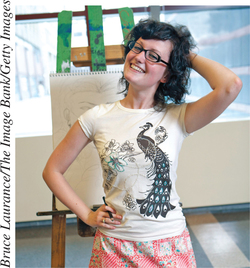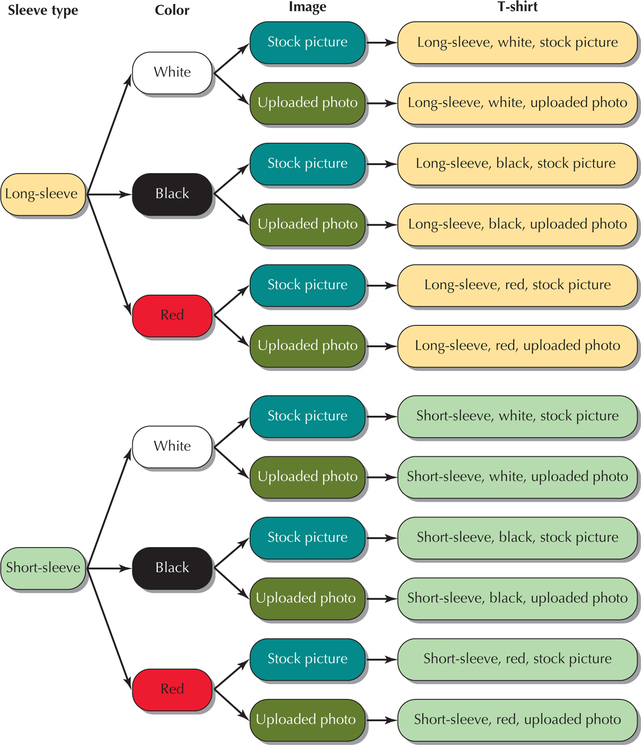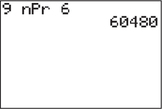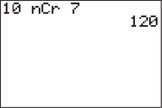5.4 Counting Methods
OBJECTIVES By the end of this section, I will be able to …
- Apply the Multiplication Rule for Counting to solve certain counting problems.
- Use permutations and combinations to solve certain counting problems.
- Compute probabilities using combinations.
Counting methods allow us to solve a range of problems, including how to compute certain probabilities.
1 Multiplication rule for counting
Let us begin with an example illustrating a general rule of counting.
EXAMPLE 33 Design your own T-shirt

A store at the local mall allows customers to design their own T-shirts. The store offers the following options to its customers:
- Sleeve type: Long-sleeve or short-sleeve
- Color: White, black, or red
- Image: Stock picture or uploaded photo
List the possible T-shirt options.
Solution
Figure 18 is a tree diagram that shows all the different T-shirts that can be designed. Two choices are available for the type of sleeve. For each sleeve type, there are three choices for color. For each color, there are two choices of image: stock picture or uploaded photo. Altogether, customers have a choice from among
2·3·2=12
different T-shirt options.
NOW YOU CAN DO
Exercises 7–10.

We can generalize the result from Example 33 as the Multiplication rule for Counting.
Multiplication rule for counting
Suppose an activity consists of a series of events in which there are a possible outcomes for the first event, b possible outcomes for the second event, c possible outcomes for the third event, and so on. Then the total number of different possible outcomes for the series of events is
a·b·c…
EXAMPLE 34 Counting with repetition: Famous initials
Some Americans in history are uniquely identified by their initials. For example, “JFK” stands for John Fitzgerald Kennedy, and “FDR” stands for Franklin Delano Roosevelt. How many different possible sets of initials are there for people with a first, middle, and last name?
Solution
Let us consider the three initials as an activity consisting of three events. Note that a particular letter may be repeated, as in “AAM” for A. A. Milne, author of Winnie the Pooh. Then there are a=26 ways to choose the first initial, b=26 ways to choose the second initial, and c=26 ways to choose the third initial. Thus, by the Multiplication Rule for Counting, the total number of different sets of initials is
26·26·26=17,576
NOW YOU CAN DO
Exercises 11 and 12.
EXAMPLE 35 Counting without repetition: Intramural singles tennis
Note: To summarize the key difference between Examples 34 and 35: If repetitions are allowed, then a=b=c. If repetitions are not allowed, then the numbers being multiplied decrease by one from left to right.
A local college has an intramural singles tennis league with five players: Ryan, Megan, Nicole, Justin, and Kyle. The college presents a trophy to the top three players in the league. How many different possible sets of three trophy winners are there?
Solution
The major difference between Example 34 and this example is that, in this example there can be no repetition. Ryan cannot finish in first place and second place. So we proceed as follows: Five possible players could finish in first place, so a=5. Now there are only four players left, one of whom will finish in second place, so b=4. That leaves only three players, one of whom will finish in third place, giving c=3. Thus, by the Multiplication Rule for Counting, the number of different possible sets of trophy winners is
5·4·3=60
NOW YOU CAN DO
Exercises 13 and 14.
YOUR TURN#21
For the situation in Example 35, suppose there are six players, and the college presents a trophy to the top four players in the league. How many different possible sets of four trophy winners are there?
(The solution is shown in Appendix A.)
EXAMPLE 36 Traveling salesman problem
A Southeast regional salesman has eight destinations that he must travel to this month: Atlanta, Raleigh, Charleston, Nashville, Jacksonville, Richmond, Mobile, and Jackson. How many different possible routes could he take?
Solution
The salesman has a=8 different choices for where to go first. Once the first destina-tion has been chosen, there are only b=7 choices for where to go second. And once the first two destinations have been chosen, there are only c=6 choices for where to go third, and so on. Thus, by the Multiplication Law for Counting, the number of dif-ferent possible routes for the salesman is
a·b·c·d·e·f·g·h=8·7·6·5·4·3·2·1=40,320
NOW YOU CAN DO
Exercises 15 and 16.
YOUR TURN#22
For the traveling salesman in Example 36, suppose there are ten destinations he must travel to. How many different possible routes could he take?
(The solution is shown in Appendix A.)
The calculation in Example 36 leads us to introduce the factorial symbol, which is used for the counting rules we will learn in the remainder of this section.
For any integer n≥0, the factorial symbol n! is defined as follows:
- 0!=1
- 1!=1
- n!=n(n-1)(n-2)…3·2·1
EXAMPLE 37 Factorials
Calculate the following factorials:
- 2!
- 3!
- 4!
- 5!
- 6!
- 7!
- 8!
Solution
- 2!=2·1=2
- 3!=3·2·1=6
- 4!=4·3·2·1=24
- 5!=5·4·3·2·1=120
- 6!=6·5·4·3·2·1=720
- 7!=7·6·5·4·3·2·1=5040
- 8!=8·7·6·5·4·3·2·1=40,320, as in Example 36
NOW YOU CAN DO
Exercises 17–22.
2 Permutations and combinations
EXAMPLE 38 Traveling to some but not all of the cities
Example 37 calculated the number of possible routes for traveling to n=8 cities. However, suppose we are interested in traveling to some but not all of the cities? For example, suppose that the salesman is traveling to three of the eight cities. Find the number of possible routes.
Solution
Eight choices are available for the first city, seven choices for the second city, and six choices for the third city. The salesman is traveling to three cities only, so the number of possible routes is thus
8·7·6=336
This result may be rewritten using factorial notation, as follows:
8·7·6=8·7·6·(5·4·3·2·1)(5·4·3·2·1)=8!5!=8!(8-3)!
NOW YOU CAN DO
Exercises 23 and 24.
YOUR TURN#24
For the traveling salesman in Example 38, suppose there are 10 destinations, but he is traveling only to 5 of the 10 destinations. Find the number of possible routes.
(The solution is shown in Appendix A.)
Example 38 leads us to the following definition.
Permutations
A permutation is an arrangement of items, such that
- r items are chosen at a time from n distinct items.
- repetition of items is not allowed.
- the order of the items is important.
The number of permutations of n items chosen r at a time is denoted as nPr and given by the formula
nPr=n!(n-r)!
In Example 38, we are looking for the number of permutations of 8 cities taken 3 at a time. We have n=8,r=3:
nPr= 8P3=n!(n-r)!=8!(8-3)!=8!5!=8·7·6=336
EXAMPLE 39 Calculating numbers of permutations
Find the following numbers of permutations:
- 5P2
- 6P2
- 6P6
Solution
- 5P2=5!(5-2)!=5·4·3!3!=20Page 296
- 6P2=6!(6-2)!=6·5·4!4!=30
- 6P6=6!(6-6)!=6·5·4·3·2·1!0!=720
NOW YOU CAN DO
Exercises 25–32.
YOUR TURN#25
Find the following numbers of permutations:
- 5P3
- 6P4
- 2P2
(The solution is shown in Appendix A.)
EXAMPLE 40 Counting permutations: Secret Santas
“Secret Santa” refers to a method whereby each member of a group anonymously buys a holiday gift for another member of the group. Each person is secretly assigned to buy a gift for another randomly chosen person in the group. Suppose Jessica, Laverne, Samantha, and Luisa share a dorm suite and want to do Secret Santa this holiday season.
- Verify that in this instance one woman purchasing a gift for another woman represents a permutation.
- Calculate how many possible different permutations of gift buying there are for the four women.
Solution
- There are n=4 women, and r=2 people are associated with each gift (the giver and the receiver).
- Each person can buy only one gift, so repetition is not allowed.
- Finally, there is a difference between Jessica buying for Laverne and Laverne buying for Jessica. Thus, order is important, and thus, buying a gift represents a permutation.
The number of permutations is calculated as follows:
nPr= 4P2=4!(4-2)!=4·3·2!2!=12
In a permutation, order is important. For example, in Example 40, there was a dif-ference between Jessica buying a gift for Laverne and Laverne buying one for Jessica. However, what if we consider shaking hands instead? Then Jessica shaking hands with Laverne is considered the same as Laverne shaking hands with Jessica. Thus, some-times order is not important. What is important here is the combination of Jessica and Laverne.
combinations
A combination is an arrangement of items in which
- r items are chosen from n distinct items.
- repetition of items is not allowed.
- the order of the items is not important.
The number of combinations of r items chosen from n different items is denoted as
nCr
EXAMPLE 41 How many combinations in the intramural tennis league?
We return to the intramural singles tennis league at the local college. There are five players: Ryan, Megan, Nicole, Justin, and Kyle. Each player must play each other once.
- Confirm that a match between two players represents a combination.
- How many matches will be held?
Solution
Let {Ryan, Megan} denote a tennis match between Ryan and Megan. Note:
- There are r=2 players chosen from n=5 players.
- Each player plays each other player once, so repetition is not allowed.
- There is no difference between {Ryan, Megan} and {Megan, Ryan}, so order is not important.
Thus, a tennis match between two players represents a combination.
- The list of all matches is as follows.
| {Ryan, Megan} | {Megan, Nicole} | {Nicole, Justin} |
| {Ryan, Nicole} | {Megan, Justin} | {Nicole, Kyle} |
| {Ryan, Justin} | {Megan, Kyle} | {Justin, Kyle} |
| {Ryan, Kyle} |
Thus, there are 5C2=10 possible matches of r=2 players chosen from n=5 players.
YOUR TURN#26
For the intramural league in Example 41, suppose there are 10 players. How many matches will be held?
(The solution is shown in Appendix A.)
We saw in Example 39 that 5P2=20 and in Example 41 that 5C2=10. Permuta-tions and combinations differ only in that ordering is ignored for combinations. To calculate the number of combinations nCr, we have to take into consideration how many different rearrangements there are of the same items. For example, in Example 41, there are r!=2!=2 rearrangements of the same players, such as {Ryan, Megan} and {Megan, Ryan}. Thus,
5C2= 5P22!=202=10
In general, the number of combinations can be computed as the number of permu-tations divided by the factorial of the number of items chosen.
Note: Following are some special combinations you may find useful. For any integer n:
nCn=1 nC0=1 nC1=n nCn-1=n
Formula for the Number of combinations
The number of combinations of r items chosen from n different items is given by
nCr=n!r!(n-r)!
For instance, in Example 41, the formula for the number of combinations is
sC2=5!2!(5-2)!=5!2!3!=5·4·3!2·1·3!=202=10
Thus, the relation: 5C2= 5P2/2! is verified.
EXAMPLE 42 Calculating numbers of combinations
Find the following numbers of combinations:
- 6C2
- 6C3
- 6C4
Solution
- 6C2=6!2!(6-2)!=6·5·4!2·1·4!=302=15
- 6C3=6!3!(6-3)!=6·5·4·3!3·2·1·3!=1206=20
- 6C4=6!4!(6-4)!=6!(6-4)!4!=6·5·4!2·1·4!=302=15
NOW YOU CAN DO
Exercises 33–40.
YOUR TURN#27
Find the following numbers of combinations:
- 5C4
- 5C3
- 5C2
(The solutions are shown in Appendix A.)
Note that in (c), we used the commutative property of multiplication (a·b=b·a) and found that 6C4= 6C2=15. In general, nCr=nCn-r for this reason.
EXAMPLE 43 Calculating the number of permutations and combinations using technology
Use the TI-83/84 and Excel to calculate the following:
- 9P6
- 10C7
Solution
We use the instructions provided in the Step-by-Step Technology Guide at the end of this section (page 302).
From Figures 19a and 19b, we find that 9P6=60,480.
 FIGURE 19a TI-83/84 permutation results.
FIGURE 19a TI-83/84 permutation results. FIGURE 19b Excel permutation results.
FIGURE 19b Excel permutation results.- From Figures 19c and 19d, we find that 10C7=120.
 FIGURE 19c TI-83/84 combination results.
FIGURE 19c TI-83/84 combination results. FIGURE 19d Excel combination results.
FIGURE 19d Excel combination results.
Sometimes we wish to find the number of permutations of items where some of the items are not distinct.
EXAMPLE 44 Permutations with nondistinct items
How many distinct strings of letters can we make by using all the letters in the word STATISTICS?
Solution
Each string will be 10 letters long and include 3 S's, 3 T's, 2 I's, 1 A, and 1 C. The 10 positions shown here need to be filled.
ˉ1 ˉ2 ˉ3 ˉ4 ˉ5 ˉ6 ˉ7 ˉ8 ˉ9 ¯10
The string-forming process is as follows:
- Step 1 Choose the positions for the three S's.
- Step 2 Choose the positions for the three T's.
- Step 3 Choose the positions for the two I's.
- Step 4 Choose the position for the one A.
- Step 5 Choose the position for the one C.
There are 10C3 ways to place the three S's in Step 1. Once Step 1 is done, seven slots are left, leaving 7C3 positions for the three T's. Once Step 2 is done, four slots are left, so there are 4C2 ways to place the two I's. Once Step 3 is done, only two slots are left, so there are only 2C1 ways to position the A. Finally, there is only 1C1 way to place the C.
Putting Steps 1–5 together, we calculate the number of distinct letter strings as
10C3⋅7C3⋅4C2⋅2C1⋅1C1=10!3!7!⋅7!3!4!⋅4!2!2!⋅2!1!1!⋅1!1!0! =10!3!3!2!1!1!=3,628,80072 =50,400
There are 50,400 distinct strings of letters that can be made using the letters in the word STATISTICS.
This example can be generalized in the following result.
Permutations of Nondistinct Items
The number of permutations of n items of which n1 are of the first kind, n2 are of the second kind, …, and nk are of the kth kind is calculated as
n!n! · n2! ·⋯· nk!
where n=n1+n2+⋯+ nk.
EXAMPLE 45 Number of permutations of nondistinct items
Brandon brings a healthy snack to school each day, consisting of 5 carrot sticks, 4 celery sticks, and 2 cherry tomatoes. If Brandon eats one item at a time, in how many different ways can he eat his snack?
Solution
We are seeking the number of permutations of n=11 items, of which n1=5 are carrot sticks, n2=4 are celery sticks, and n3=2 are cherry tomatoes. Using the formula for the number of permutations of nondistinct items,
n!n1! · n2! · n3!=11!5! · 4! · 2!=39,916,800120· 24·2=6930
There are 6930 distinct ways in which Brandon can eat his snack.
NOW YOU CAN DO
Exercises 41 and 42.
Acceptance sampling refers to the process of (1) selecting a random sample from a batch of items, (2) evaluating the sample for defectives, and (3) either accepting or rejecting the entire batch based on the evaluation of the sample.
EXAMPLE 46 Acceptance sampling uses combinations
Suppose we have a batch of 20 cell phones, of which, unknown to us, 3 are defective and 17 are nondefective; we will take a random sample of size 2 and evaluate both items once.
- Are the arrangements in acceptance sampling permutations or combinations?
- Find the number of ways that both sampled cell phones are defective.
Solution
- Both permutations and combinations require the following:
- r items are chosen from n distinct items. Here, we are selecting r=2 phones from a batch of n=20.
- Repetition of the items is not allowed. Each item is evaluated only once. The difference between permutations and combinations is that, for permutations, order is important, whereas for combinations, order is not important. In acceptance sampling, the order of the items is not important. Thus, acceptance sampling uses combinations.
The number of ways of choosing two of the three defectives is
3C2=3!2!(3-2)!=3·2!2!·1!=3
Selecting 2 defectives means that we are choosing 0 of the 17 nondefectives. The number of ways this can happen is
17C0=17!0!(17-0)!=17!1·17!=1
By the Multiplication Rule for Counting, the number of ways that both sampled cell phones are defective is
3C2· 17C0=3·1=3
3 Computing Probabilities Using Combinations
The counting methods we have learned in this section may be used to compute probabilities. We assume that each possible outcome in a random sample is equally likely, and thus we use the classical method for assigning the probability of an event E:
P(E)=number of outcomes in Enumber of outcomes in sample space=N(E)N(S)
EXAMPLE 47 probability using combinations: Acceptance sampling
Continuing with Example 46, if both cell phones in the sample of size 2 are defective,we will reject the batch and cancel our contract with the supplier.
- What is the number of ways that both cell phones will be defective?
- What is the number of outcomes in this sample space?
- What is the probability that both cell phones will be defective?
Solution
- From Example 46, the number of ways that both cell phones will be defective is
3C2· 17C0=3·1=3
- The number of outcomes in the sample space is given by the number of ways of selecting 2 cell phones out of a batch of 20; that is,
N(S)= 20C2=20!2!(20-2)!=20·19·18!2! ·18!=3802=190
- Therefore, the probability that both cell phones will be defective is given by
P(Both defective)=number of ways both defectivenumber of outcomes in sample space=3190≈0.01579
EXAMPLE 48 Florida Lotto
You can win the jackpot in the Florida Lotto by correctly choosing all 6 winning numbers out of the numbers 1–53.
- What is the number of ways of winning the jackpot by choosing all 6 winning numbers?
- What is the number of outcomes in this sample space?
- If you buy a single ticket for $1, what is your probability of winning the jackpot?
- If you mortgage your house and buy 500,000 tickets, what is your probability of winning the jackpot (assuming that all the tickets are different)?
Solution
- The number of ways of winning the jackpot by correctly choosing all 6 of the winning numbers and none of the losing numbers is
N(Jackpot)= 6C6· 47C0=1·1=1
Page 302 The size of the sample space is
N(S)=C53=53!6!(53−6)!=53⋅52⋅51⋅50⋅49⋅48⋅47!6!⋅47!=16,529,385,600720=22,957,480
Therefore, if you buy a single ticket for $1, your probability of winning the jackpot is given by
P(Jackpot)=122,957,480≈0.00000004356
If you buy 500,000 tickets and they are all unique, then your probability of winning becomes
P(Jackpot)=500,00022,957,480≈0.02178
This is because the unique tickets are mutually exclusive, and the Addition Rule for Mutually Exclusive Events allows us to add the probabilities of the 500,000 tickets.After mortgaging your $500,000 house and buying lottery tickets with the proceeds, there is a better than 97% probability that you will not win the lottery.